Marketing Plan for Coca-Cola: Analysis and Strategy
VerifiedAdded on 2021/07/09
|27
|6769
|121
Report
AI Summary
This report presents a comprehensive analysis of Coca-Cola's marketing strategies, examining its key functions, roles, and responsibilities within the organization. It explores the interrelationships between marketing and other functional units, such as manufacturing and finance. The report delves into the marketing environment using PESTEL and SWOT analyses to assess macro and micro-environmental factors. A strategic marketing plan is developed, evaluating the application of the 7Ps marketing mix elements and comparing Coca-Cola's approach with a key competitor, Pepsi. The analysis covers demand stimulation, product development, research and development, planning, and public relations. The report also examines Coca-Cola's organizational structure and the interaction between marketing and other departments. The conclusion summarizes the key findings and provides insights for future development.
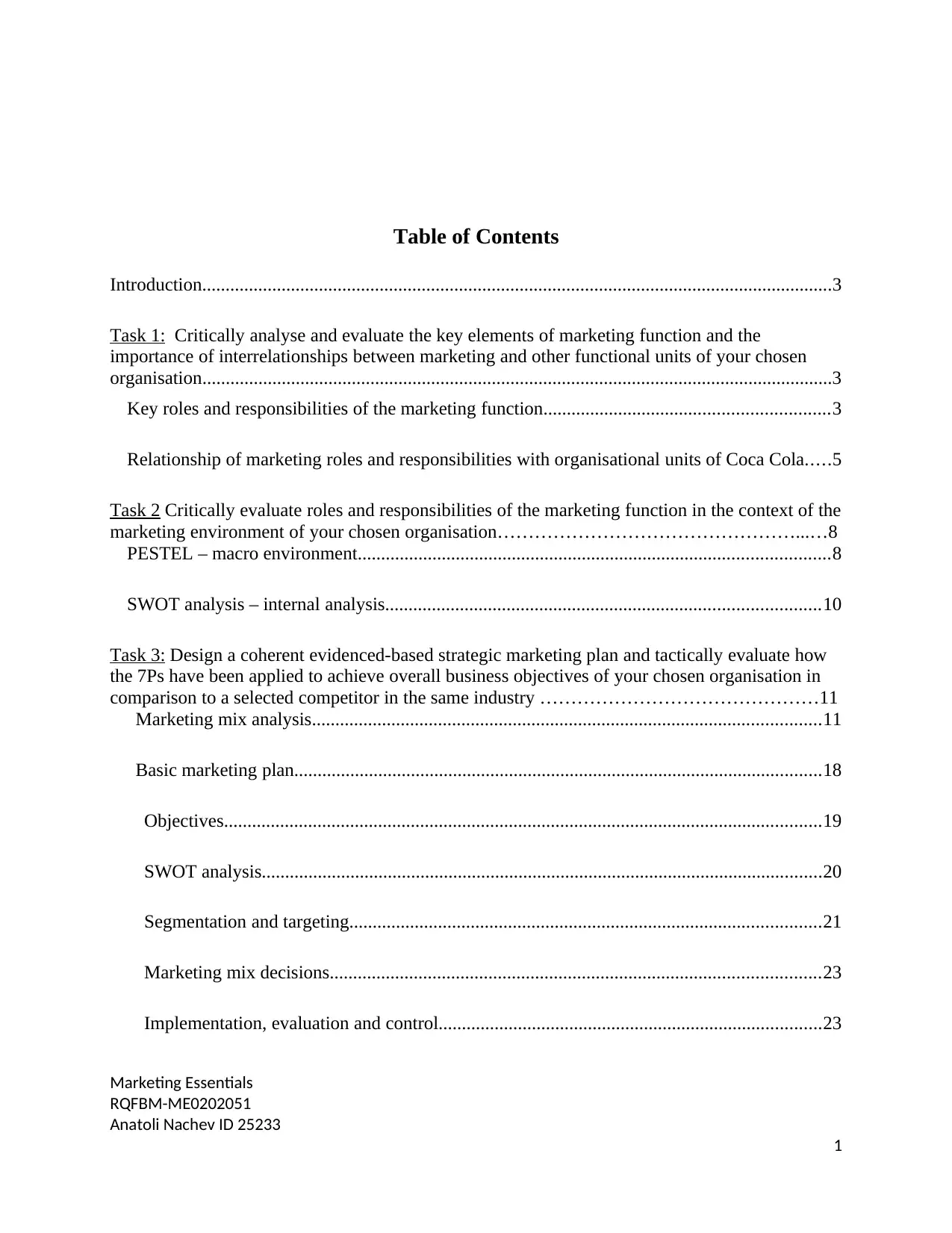
Table of Contents
Introduction.......................................................................................................................................3
Task 1: Critically analyse and evaluate the key elements of marketing function and the
importance of interrelationships between marketing and other functional units of your chosen
organisation.......................................................................................................................................3
Key roles and responsibilities of the marketing function.............................................................3
Relationship of marketing roles and responsibilities with organisational units of Coca Cola.....5
Task 2 Critically evaluate roles and responsibilities of the marketing function in the context of the
marketing environment of your chosen organisation…………………………………………...…8
PESTEL – macro environment.....................................................................................................8
SWOT analysis – internal analysis.............................................................................................10
Task 3: Design a coherent evidenced-based strategic marketing plan and tactically evaluate how
the 7Ps have been applied to achieve overall business objectives of your chosen organisation in
comparison to a selected competitor in the same industry ………………………………………11
Marketing mix analysis.............................................................................................................11
Basic marketing plan.................................................................................................................18
Objectives................................................................................................................................19
SWOT analysis........................................................................................................................20
Segmentation and targeting.....................................................................................................21
Marketing mix decisions.........................................................................................................23
Implementation, evaluation and control..................................................................................23
Marketing Essentials
RQFBM-ME0202051
Anatoli Nachev ID 25233
1
Introduction.......................................................................................................................................3
Task 1: Critically analyse and evaluate the key elements of marketing function and the
importance of interrelationships between marketing and other functional units of your chosen
organisation.......................................................................................................................................3
Key roles and responsibilities of the marketing function.............................................................3
Relationship of marketing roles and responsibilities with organisational units of Coca Cola.....5
Task 2 Critically evaluate roles and responsibilities of the marketing function in the context of the
marketing environment of your chosen organisation…………………………………………...…8
PESTEL – macro environment.....................................................................................................8
SWOT analysis – internal analysis.............................................................................................10
Task 3: Design a coherent evidenced-based strategic marketing plan and tactically evaluate how
the 7Ps have been applied to achieve overall business objectives of your chosen organisation in
comparison to a selected competitor in the same industry ………………………………………11
Marketing mix analysis.............................................................................................................11
Basic marketing plan.................................................................................................................18
Objectives................................................................................................................................19
SWOT analysis........................................................................................................................20
Segmentation and targeting.....................................................................................................21
Marketing mix decisions.........................................................................................................23
Implementation, evaluation and control..................................................................................23
Marketing Essentials
RQFBM-ME0202051
Anatoli Nachev ID 25233
1
Paraphrase This Document
Need a fresh take? Get an instant paraphrase of this document with our AI Paraphraser
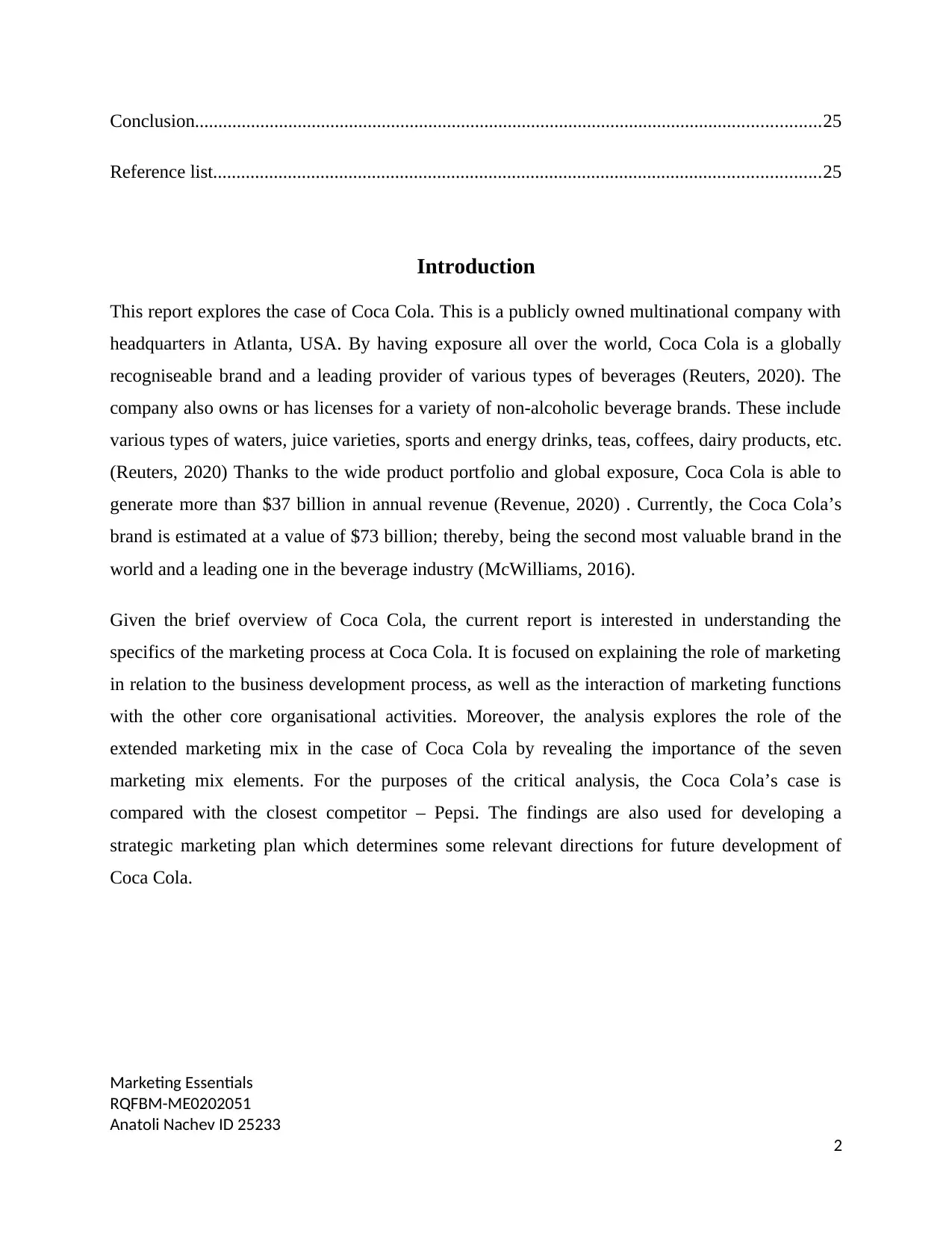
Conclusion......................................................................................................................................25
Reference list..................................................................................................................................25
Introduction
This report explores the case of Coca Cola. This is a publicly owned multinational company with
headquarters in Atlanta, USA. By having exposure all over the world, Coca Cola is a globally
recogniseable brand and a leading provider of various types of beverages (Reuters, 2020). The
company also owns or has licenses for a variety of non-alcoholic beverage brands. These include
various types of waters, juice varieties, sports and energy drinks, teas, coffees, dairy products, etc.
(Reuters, 2020) Thanks to the wide product portfolio and global exposure, Coca Cola is able to
generate more than $37 billion in annual revenue (Revenue, 2020) . Currently, the Coca Cola’s
brand is estimated at a value of $73 billion; thereby, being the second most valuable brand in the
world and a leading one in the beverage industry (McWilliams, 2016).
Given the brief overview of Coca Cola, the current report is interested in understanding the
specifics of the marketing process at Coca Cola. It is focused on explaining the role of marketing
in relation to the business development process, as well as the interaction of marketing functions
with the other core organisational activities. Moreover, the analysis explores the role of the
extended marketing mix in the case of Coca Cola by revealing the importance of the seven
marketing mix elements. For the purposes of the critical analysis, the Coca Cola’s case is
compared with the closest competitor – Pepsi. The findings are also used for developing a
strategic marketing plan which determines some relevant directions for future development of
Coca Cola.
Marketing Essentials
RQFBM-ME0202051
Anatoli Nachev ID 25233
2
Reference list..................................................................................................................................25
Introduction
This report explores the case of Coca Cola. This is a publicly owned multinational company with
headquarters in Atlanta, USA. By having exposure all over the world, Coca Cola is a globally
recogniseable brand and a leading provider of various types of beverages (Reuters, 2020). The
company also owns or has licenses for a variety of non-alcoholic beverage brands. These include
various types of waters, juice varieties, sports and energy drinks, teas, coffees, dairy products, etc.
(Reuters, 2020) Thanks to the wide product portfolio and global exposure, Coca Cola is able to
generate more than $37 billion in annual revenue (Revenue, 2020) . Currently, the Coca Cola’s
brand is estimated at a value of $73 billion; thereby, being the second most valuable brand in the
world and a leading one in the beverage industry (McWilliams, 2016).
Given the brief overview of Coca Cola, the current report is interested in understanding the
specifics of the marketing process at Coca Cola. It is focused on explaining the role of marketing
in relation to the business development process, as well as the interaction of marketing functions
with the other core organisational activities. Moreover, the analysis explores the role of the
extended marketing mix in the case of Coca Cola by revealing the importance of the seven
marketing mix elements. For the purposes of the critical analysis, the Coca Cola’s case is
compared with the closest competitor – Pepsi. The findings are also used for developing a
strategic marketing plan which determines some relevant directions for future development of
Coca Cola.
Marketing Essentials
RQFBM-ME0202051
Anatoli Nachev ID 25233
2
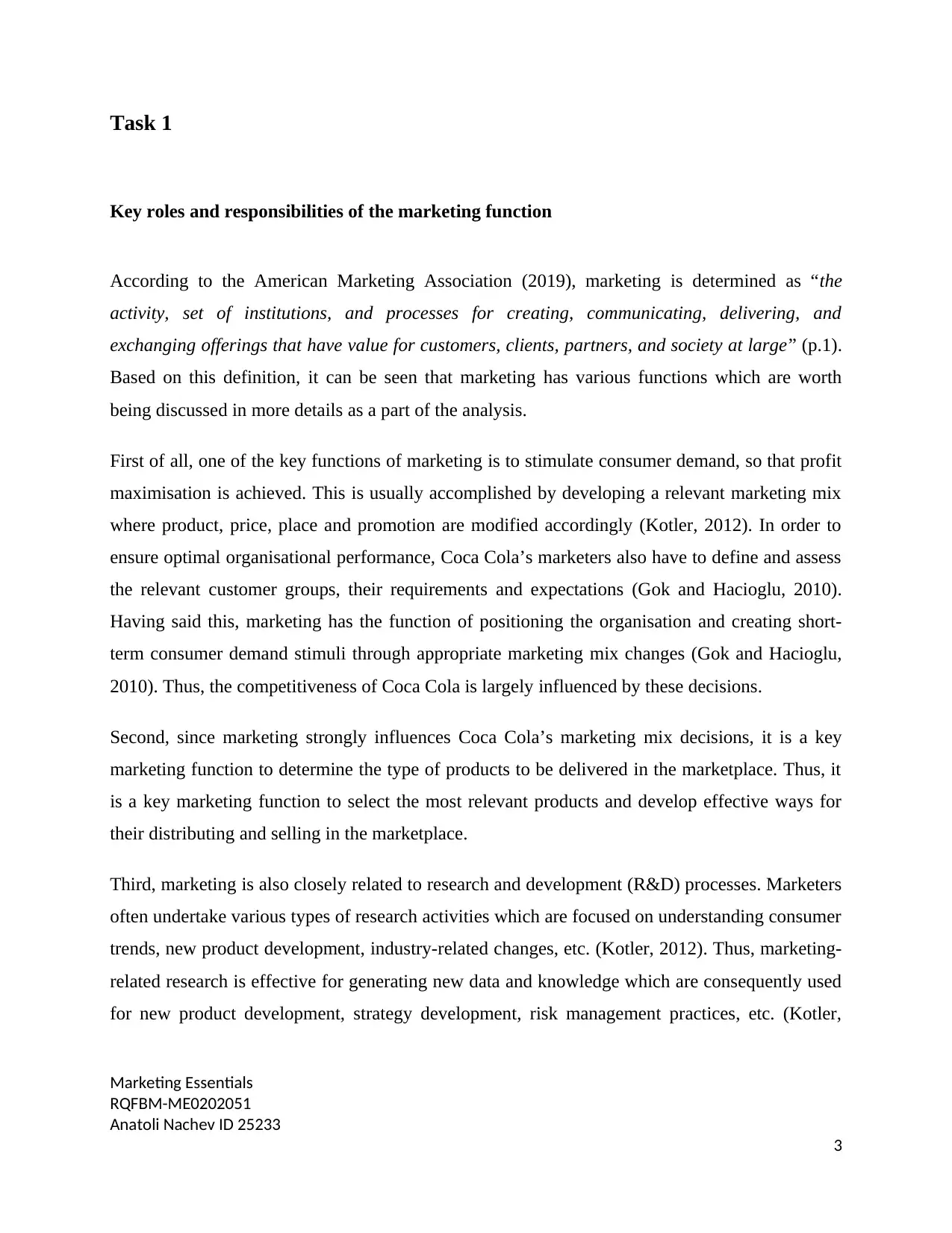
Task 1
Key roles and responsibilities of the marketing function
According to the American Marketing Association (2019), marketing is determined as “the
activity, set of institutions, and processes for creating, communicating, delivering, and
exchanging offerings that have value for customers, clients, partners, and society at large” (p.1).
Based on this definition, it can be seen that marketing has various functions which are worth
being discussed in more details as a part of the analysis.
First of all, one of the key functions of marketing is to stimulate consumer demand, so that profit
maximisation is achieved. This is usually accomplished by developing a relevant marketing mix
where product, price, place and promotion are modified accordingly (Kotler, 2012). In order to
ensure optimal organisational performance, Coca Cola’s marketers also have to define and assess
the relevant customer groups, their requirements and expectations (Gok and Hacioglu, 2010).
Having said this, marketing has the function of positioning the organisation and creating short-
term consumer demand stimuli through appropriate marketing mix changes (Gok and Hacioglu,
2010). Thus, the competitiveness of Coca Cola is largely influenced by these decisions.
Second, since marketing strongly influences Coca Cola’s marketing mix decisions, it is a key
marketing function to determine the type of products to be delivered in the marketplace. Thus, it
is a key marketing function to select the most relevant products and develop effective ways for
their distributing and selling in the marketplace.
Third, marketing is also closely related to research and development (R&D) processes. Marketers
often undertake various types of research activities which are focused on understanding consumer
trends, new product development, industry-related changes, etc. (Kotler, 2012). Thus, marketing-
related research is effective for generating new data and knowledge which are consequently used
for new product development, strategy development, risk management practices, etc. (Kotler,
Marketing Essentials
RQFBM-ME0202051
Anatoli Nachev ID 25233
3
Key roles and responsibilities of the marketing function
According to the American Marketing Association (2019), marketing is determined as “the
activity, set of institutions, and processes for creating, communicating, delivering, and
exchanging offerings that have value for customers, clients, partners, and society at large” (p.1).
Based on this definition, it can be seen that marketing has various functions which are worth
being discussed in more details as a part of the analysis.
First of all, one of the key functions of marketing is to stimulate consumer demand, so that profit
maximisation is achieved. This is usually accomplished by developing a relevant marketing mix
where product, price, place and promotion are modified accordingly (Kotler, 2012). In order to
ensure optimal organisational performance, Coca Cola’s marketers also have to define and assess
the relevant customer groups, their requirements and expectations (Gok and Hacioglu, 2010).
Having said this, marketing has the function of positioning the organisation and creating short-
term consumer demand stimuli through appropriate marketing mix changes (Gok and Hacioglu,
2010). Thus, the competitiveness of Coca Cola is largely influenced by these decisions.
Second, since marketing strongly influences Coca Cola’s marketing mix decisions, it is a key
marketing function to determine the type of products to be delivered in the marketplace. Thus, it
is a key marketing function to select the most relevant products and develop effective ways for
their distributing and selling in the marketplace.
Third, marketing is also closely related to research and development (R&D) processes. Marketers
often undertake various types of research activities which are focused on understanding consumer
trends, new product development, industry-related changes, etc. (Kotler, 2012). Thus, marketing-
related research is effective for generating new data and knowledge which are consequently used
for new product development, strategy development, risk management practices, etc. (Kotler,
Marketing Essentials
RQFBM-ME0202051
Anatoli Nachev ID 25233
3
⊘ This is a preview!⊘
Do you want full access?
Subscribe today to unlock all pages.

Trusted by 1+ million students worldwide
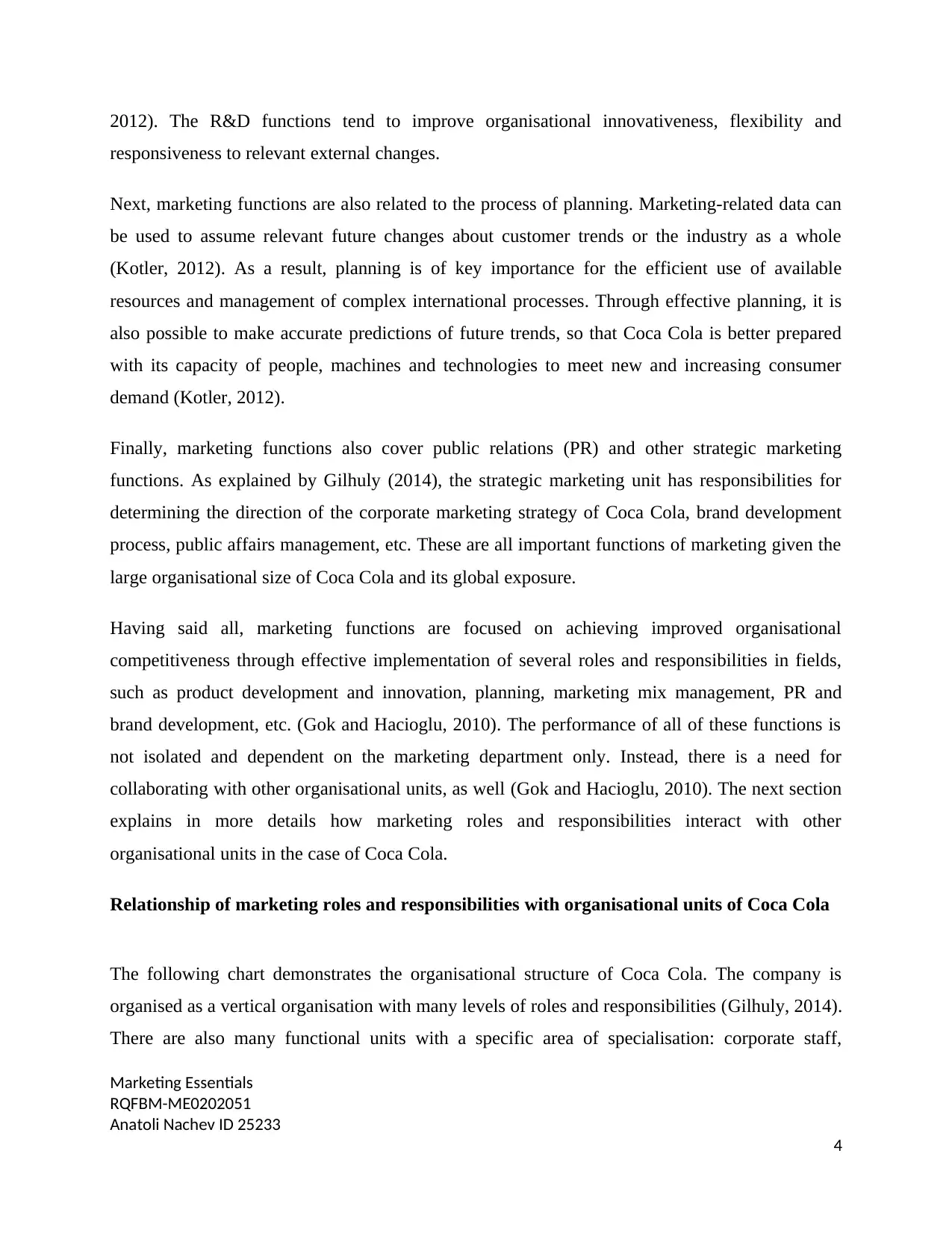
2012). The R&D functions tend to improve organisational innovativeness, flexibility and
responsiveness to relevant external changes.
Next, marketing functions are also related to the process of planning. Marketing-related data can
be used to assume relevant future changes about customer trends or the industry as a whole
(Kotler, 2012). As a result, planning is of key importance for the efficient use of available
resources and management of complex international processes. Through effective planning, it is
also possible to make accurate predictions of future trends, so that Coca Cola is better prepared
with its capacity of people, machines and technologies to meet new and increasing consumer
demand (Kotler, 2012).
Finally, marketing functions also cover public relations (PR) and other strategic marketing
functions. As explained by Gilhuly (2014), the strategic marketing unit has responsibilities for
determining the direction of the corporate marketing strategy of Coca Cola, brand development
process, public affairs management, etc. These are all important functions of marketing given the
large organisational size of Coca Cola and its global exposure.
Having said all, marketing functions are focused on achieving improved organisational
competitiveness through effective implementation of several roles and responsibilities in fields,
such as product development and innovation, planning, marketing mix management, PR and
brand development, etc. (Gok and Hacioglu, 2010). The performance of all of these functions is
not isolated and dependent on the marketing department only. Instead, there is a need for
collaborating with other organisational units, as well (Gok and Hacioglu, 2010). The next section
explains in more details how marketing roles and responsibilities interact with other
organisational units in the case of Coca Cola.
Relationship of marketing roles and responsibilities with organisational units of Coca Cola
The following chart demonstrates the organisational structure of Coca Cola. The company is
organised as a vertical organisation with many levels of roles and responsibilities (Gilhuly, 2014).
There are also many functional units with a specific area of specialisation: corporate staff,
Marketing Essentials
RQFBM-ME0202051
Anatoli Nachev ID 25233
4
responsiveness to relevant external changes.
Next, marketing functions are also related to the process of planning. Marketing-related data can
be used to assume relevant future changes about customer trends or the industry as a whole
(Kotler, 2012). As a result, planning is of key importance for the efficient use of available
resources and management of complex international processes. Through effective planning, it is
also possible to make accurate predictions of future trends, so that Coca Cola is better prepared
with its capacity of people, machines and technologies to meet new and increasing consumer
demand (Kotler, 2012).
Finally, marketing functions also cover public relations (PR) and other strategic marketing
functions. As explained by Gilhuly (2014), the strategic marketing unit has responsibilities for
determining the direction of the corporate marketing strategy of Coca Cola, brand development
process, public affairs management, etc. These are all important functions of marketing given the
large organisational size of Coca Cola and its global exposure.
Having said all, marketing functions are focused on achieving improved organisational
competitiveness through effective implementation of several roles and responsibilities in fields,
such as product development and innovation, planning, marketing mix management, PR and
brand development, etc. (Gok and Hacioglu, 2010). The performance of all of these functions is
not isolated and dependent on the marketing department only. Instead, there is a need for
collaborating with other organisational units, as well (Gok and Hacioglu, 2010). The next section
explains in more details how marketing roles and responsibilities interact with other
organisational units in the case of Coca Cola.
Relationship of marketing roles and responsibilities with organisational units of Coca Cola
The following chart demonstrates the organisational structure of Coca Cola. The company is
organised as a vertical organisation with many levels of roles and responsibilities (Gilhuly, 2014).
There are also many functional units with a specific area of specialisation: corporate staff,
Marketing Essentials
RQFBM-ME0202051
Anatoli Nachev ID 25233
4
Paraphrase This Document
Need a fresh take? Get an instant paraphrase of this document with our AI Paraphraser
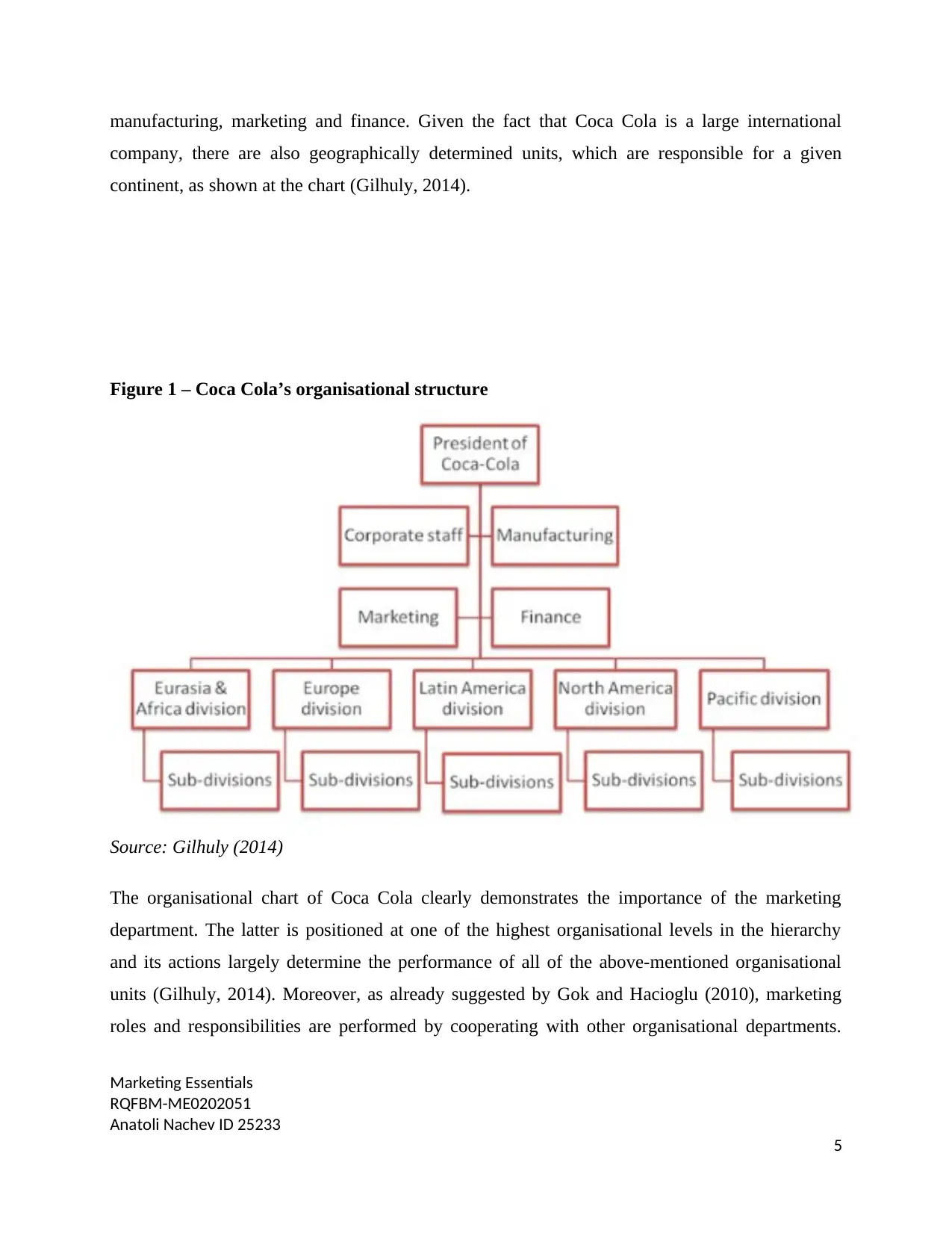
manufacturing, marketing and finance. Given the fact that Coca Cola is a large international
company, there are also geographically determined units, which are responsible for a given
continent, as shown at the chart (Gilhuly, 2014).
Figure 1 – Coca Cola’s organisational structure
Source: Gilhuly (2014)
The organisational chart of Coca Cola clearly demonstrates the importance of the marketing
department. The latter is positioned at one of the highest organisational levels in the hierarchy
and its actions largely determine the performance of all of the above-mentioned organisational
units (Gilhuly, 2014). Moreover, as already suggested by Gok and Hacioglu (2010), marketing
roles and responsibilities are performed by cooperating with other organisational departments.
Marketing Essentials
RQFBM-ME0202051
Anatoli Nachev ID 25233
5
company, there are also geographically determined units, which are responsible for a given
continent, as shown at the chart (Gilhuly, 2014).
Figure 1 – Coca Cola’s organisational structure
Source: Gilhuly (2014)
The organisational chart of Coca Cola clearly demonstrates the importance of the marketing
department. The latter is positioned at one of the highest organisational levels in the hierarchy
and its actions largely determine the performance of all of the above-mentioned organisational
units (Gilhuly, 2014). Moreover, as already suggested by Gok and Hacioglu (2010), marketing
roles and responsibilities are performed by cooperating with other organisational departments.
Marketing Essentials
RQFBM-ME0202051
Anatoli Nachev ID 25233
5
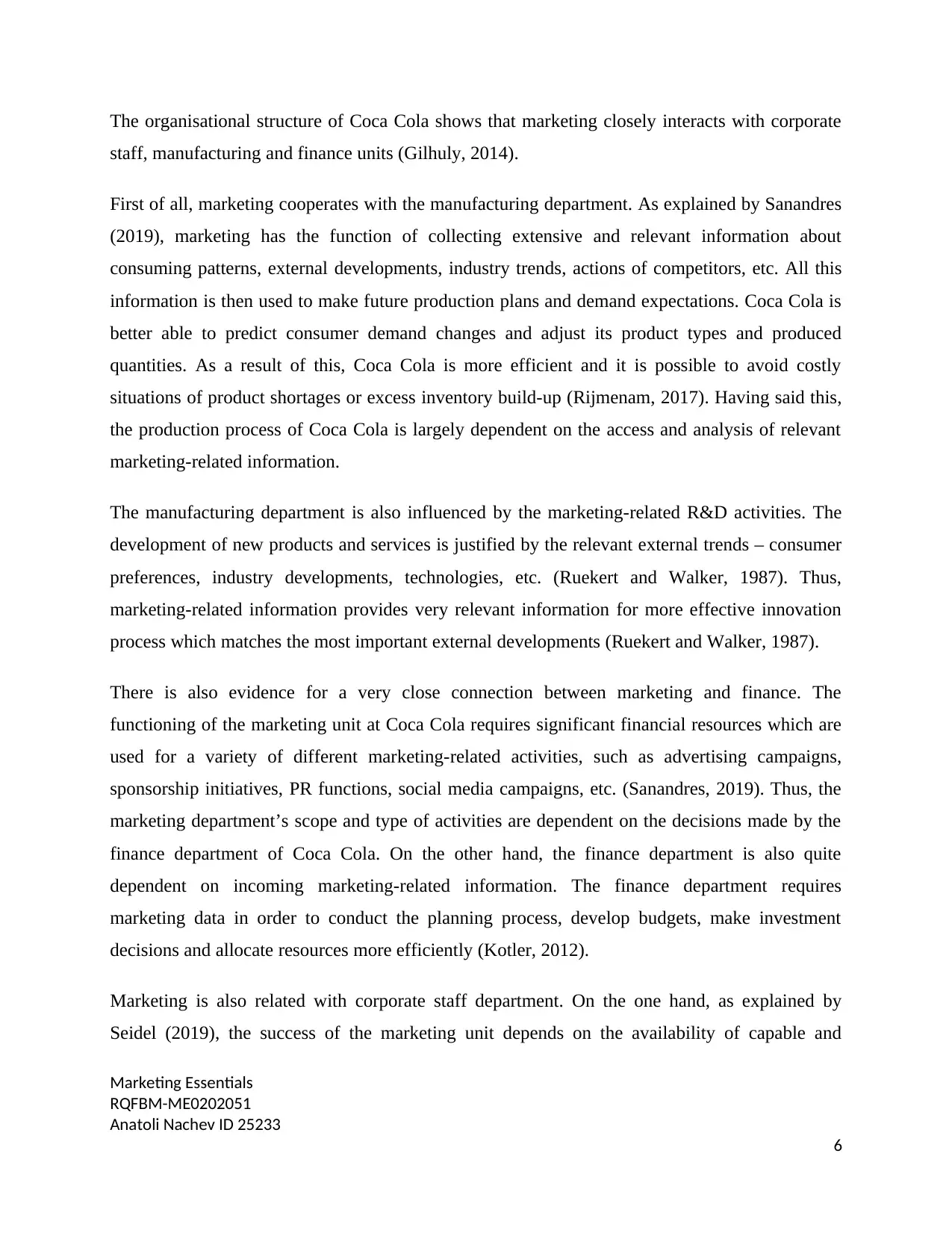
The organisational structure of Coca Cola shows that marketing closely interacts with corporate
staff, manufacturing and finance units (Gilhuly, 2014).
First of all, marketing cooperates with the manufacturing department. As explained by Sanandres
(2019), marketing has the function of collecting extensive and relevant information about
consuming patterns, external developments, industry trends, actions of competitors, etc. All this
information is then used to make future production plans and demand expectations. Coca Cola is
better able to predict consumer demand changes and adjust its product types and produced
quantities. As a result of this, Coca Cola is more efficient and it is possible to avoid costly
situations of product shortages or excess inventory build-up (Rijmenam, 2017). Having said this,
the production process of Coca Cola is largely dependent on the access and analysis of relevant
marketing-related information.
The manufacturing department is also influenced by the marketing-related R&D activities. The
development of new products and services is justified by the relevant external trends – consumer
preferences, industry developments, technologies, etc. (Ruekert and Walker, 1987). Thus,
marketing-related information provides very relevant information for more effective innovation
process which matches the most important external developments (Ruekert and Walker, 1987).
There is also evidence for a very close connection between marketing and finance. The
functioning of the marketing unit at Coca Cola requires significant financial resources which are
used for a variety of different marketing-related activities, such as advertising campaigns,
sponsorship initiatives, PR functions, social media campaigns, etc. (Sanandres, 2019). Thus, the
marketing department’s scope and type of activities are dependent on the decisions made by the
finance department of Coca Cola. On the other hand, the finance department is also quite
dependent on incoming marketing-related information. The finance department requires
marketing data in order to conduct the planning process, develop budgets, make investment
decisions and allocate resources more efficiently (Kotler, 2012).
Marketing is also related with corporate staff department. On the one hand, as explained by
Seidel (2019), the success of the marketing unit depends on the availability of capable and
Marketing Essentials
RQFBM-ME0202051
Anatoli Nachev ID 25233
6
staff, manufacturing and finance units (Gilhuly, 2014).
First of all, marketing cooperates with the manufacturing department. As explained by Sanandres
(2019), marketing has the function of collecting extensive and relevant information about
consuming patterns, external developments, industry trends, actions of competitors, etc. All this
information is then used to make future production plans and demand expectations. Coca Cola is
better able to predict consumer demand changes and adjust its product types and produced
quantities. As a result of this, Coca Cola is more efficient and it is possible to avoid costly
situations of product shortages or excess inventory build-up (Rijmenam, 2017). Having said this,
the production process of Coca Cola is largely dependent on the access and analysis of relevant
marketing-related information.
The manufacturing department is also influenced by the marketing-related R&D activities. The
development of new products and services is justified by the relevant external trends – consumer
preferences, industry developments, technologies, etc. (Ruekert and Walker, 1987). Thus,
marketing-related information provides very relevant information for more effective innovation
process which matches the most important external developments (Ruekert and Walker, 1987).
There is also evidence for a very close connection between marketing and finance. The
functioning of the marketing unit at Coca Cola requires significant financial resources which are
used for a variety of different marketing-related activities, such as advertising campaigns,
sponsorship initiatives, PR functions, social media campaigns, etc. (Sanandres, 2019). Thus, the
marketing department’s scope and type of activities are dependent on the decisions made by the
finance department of Coca Cola. On the other hand, the finance department is also quite
dependent on incoming marketing-related information. The finance department requires
marketing data in order to conduct the planning process, develop budgets, make investment
decisions and allocate resources more efficiently (Kotler, 2012).
Marketing is also related with corporate staff department. On the one hand, as explained by
Seidel (2019), the success of the marketing unit depends on the availability of capable and
Marketing Essentials
RQFBM-ME0202051
Anatoli Nachev ID 25233
6
⊘ This is a preview!⊘
Do you want full access?
Subscribe today to unlock all pages.

Trusted by 1+ million students worldwide
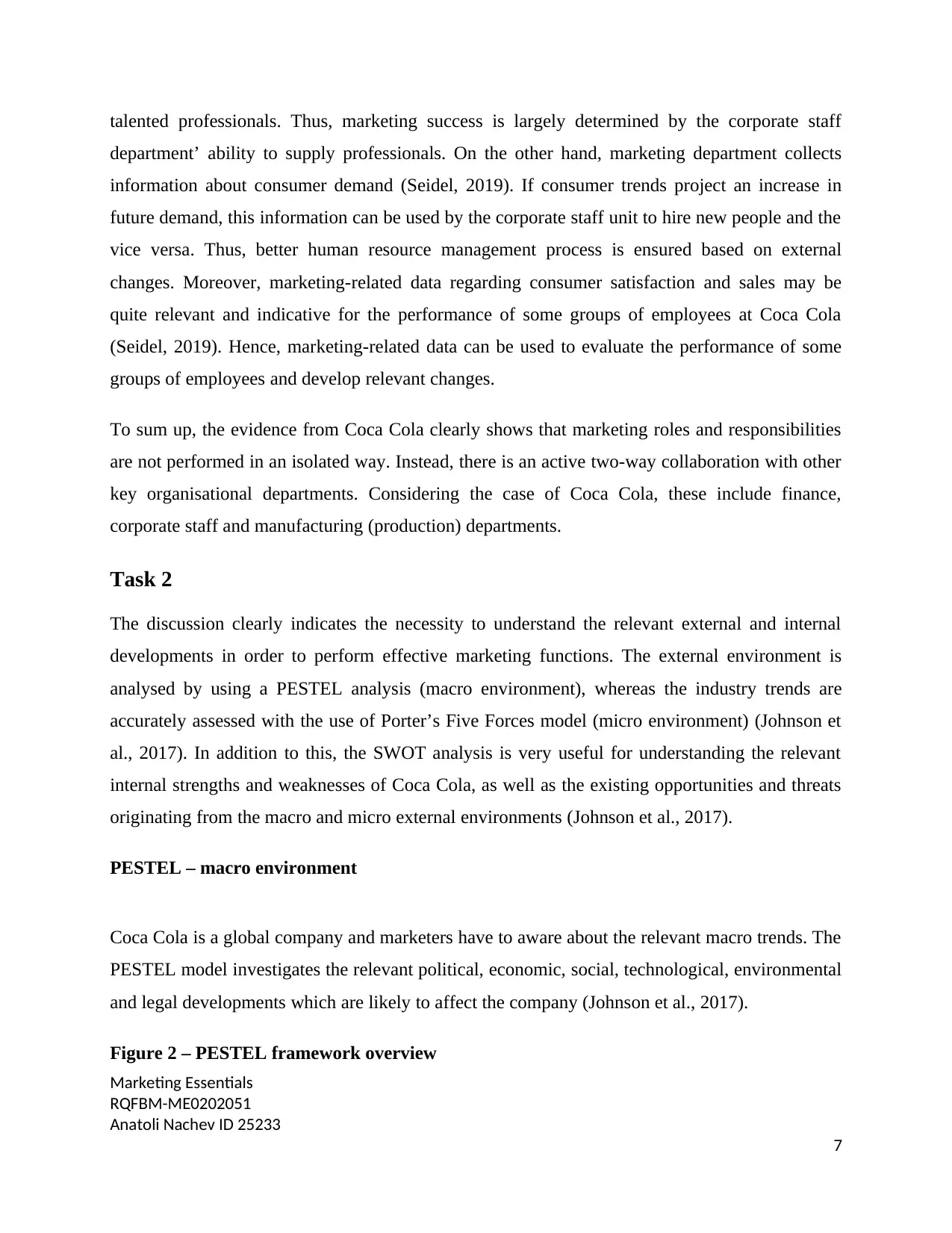
talented professionals. Thus, marketing success is largely determined by the corporate staff
department’ ability to supply professionals. On the other hand, marketing department collects
information about consumer demand (Seidel, 2019). If consumer trends project an increase in
future demand, this information can be used by the corporate staff unit to hire new people and the
vice versa. Thus, better human resource management process is ensured based on external
changes. Moreover, marketing-related data regarding consumer satisfaction and sales may be
quite relevant and indicative for the performance of some groups of employees at Coca Cola
(Seidel, 2019). Hence, marketing-related data can be used to evaluate the performance of some
groups of employees and develop relevant changes.
To sum up, the evidence from Coca Cola clearly shows that marketing roles and responsibilities
are not performed in an isolated way. Instead, there is an active two-way collaboration with other
key organisational departments. Considering the case of Coca Cola, these include finance,
corporate staff and manufacturing (production) departments.
Task 2
The discussion clearly indicates the necessity to understand the relevant external and internal
developments in order to perform effective marketing functions. The external environment is
analysed by using a PESTEL analysis (macro environment), whereas the industry trends are
accurately assessed with the use of Porter’s Five Forces model (micro environment) (Johnson et
al., 2017). In addition to this, the SWOT analysis is very useful for understanding the relevant
internal strengths and weaknesses of Coca Cola, as well as the existing opportunities and threats
originating from the macro and micro external environments (Johnson et al., 2017).
PESTEL – macro environment
Coca Cola is a global company and marketers have to aware about the relevant macro trends. The
PESTEL model investigates the relevant political, economic, social, technological, environmental
and legal developments which are likely to affect the company (Johnson et al., 2017).
Figure 2 – PESTEL framework overview
Marketing Essentials
RQFBM-ME0202051
Anatoli Nachev ID 25233
7
department’ ability to supply professionals. On the other hand, marketing department collects
information about consumer demand (Seidel, 2019). If consumer trends project an increase in
future demand, this information can be used by the corporate staff unit to hire new people and the
vice versa. Thus, better human resource management process is ensured based on external
changes. Moreover, marketing-related data regarding consumer satisfaction and sales may be
quite relevant and indicative for the performance of some groups of employees at Coca Cola
(Seidel, 2019). Hence, marketing-related data can be used to evaluate the performance of some
groups of employees and develop relevant changes.
To sum up, the evidence from Coca Cola clearly shows that marketing roles and responsibilities
are not performed in an isolated way. Instead, there is an active two-way collaboration with other
key organisational departments. Considering the case of Coca Cola, these include finance,
corporate staff and manufacturing (production) departments.
Task 2
The discussion clearly indicates the necessity to understand the relevant external and internal
developments in order to perform effective marketing functions. The external environment is
analysed by using a PESTEL analysis (macro environment), whereas the industry trends are
accurately assessed with the use of Porter’s Five Forces model (micro environment) (Johnson et
al., 2017). In addition to this, the SWOT analysis is very useful for understanding the relevant
internal strengths and weaknesses of Coca Cola, as well as the existing opportunities and threats
originating from the macro and micro external environments (Johnson et al., 2017).
PESTEL – macro environment
Coca Cola is a global company and marketers have to aware about the relevant macro trends. The
PESTEL model investigates the relevant political, economic, social, technological, environmental
and legal developments which are likely to affect the company (Johnson et al., 2017).
Figure 2 – PESTEL framework overview
Marketing Essentials
RQFBM-ME0202051
Anatoli Nachev ID 25233
7
Paraphrase This Document
Need a fresh take? Get an instant paraphrase of this document with our AI Paraphraser
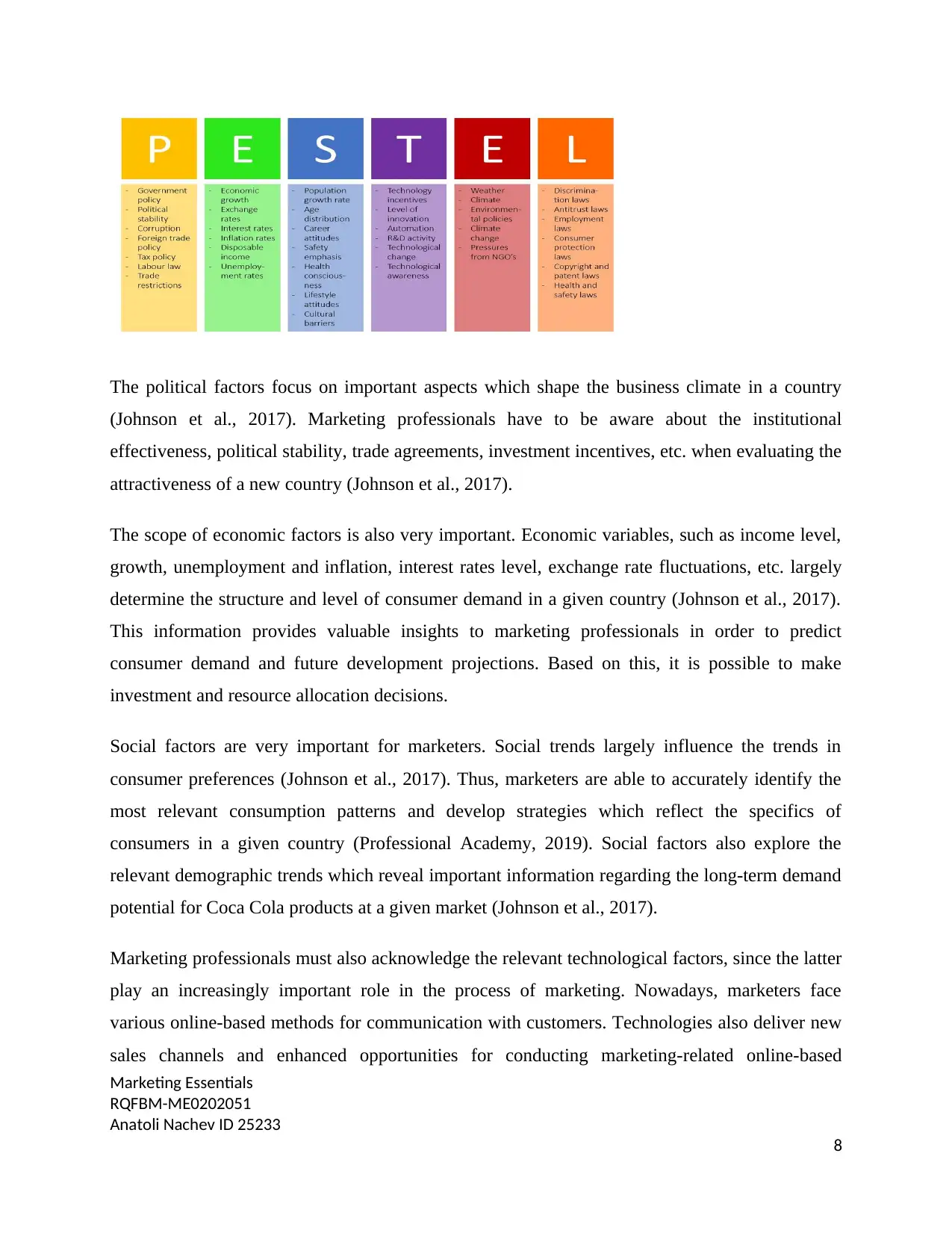
The political factors focus on important aspects which shape the business climate in a country
(Johnson et al., 2017). Marketing professionals have to be aware about the institutional
effectiveness, political stability, trade agreements, investment incentives, etc. when evaluating the
attractiveness of a new country (Johnson et al., 2017).
The scope of economic factors is also very important. Economic variables, such as income level,
growth, unemployment and inflation, interest rates level, exchange rate fluctuations, etc. largely
determine the structure and level of consumer demand in a given country (Johnson et al., 2017).
This information provides valuable insights to marketing professionals in order to predict
consumer demand and future development projections. Based on this, it is possible to make
investment and resource allocation decisions.
Social factors are very important for marketers. Social trends largely influence the trends in
consumer preferences (Johnson et al., 2017). Thus, marketers are able to accurately identify the
most relevant consumption patterns and develop strategies which reflect the specifics of
consumers in a given country (Professional Academy, 2019). Social factors also explore the
relevant demographic trends which reveal important information regarding the long-term demand
potential for Coca Cola products at a given market (Johnson et al., 2017).
Marketing professionals must also acknowledge the relevant technological factors, since the latter
play an increasingly important role in the process of marketing. Nowadays, marketers face
various online-based methods for communication with customers. Technologies also deliver new
sales channels and enhanced opportunities for conducting marketing-related online-based
Marketing Essentials
RQFBM-ME0202051
Anatoli Nachev ID 25233
8
(Johnson et al., 2017). Marketing professionals have to be aware about the institutional
effectiveness, political stability, trade agreements, investment incentives, etc. when evaluating the
attractiveness of a new country (Johnson et al., 2017).
The scope of economic factors is also very important. Economic variables, such as income level,
growth, unemployment and inflation, interest rates level, exchange rate fluctuations, etc. largely
determine the structure and level of consumer demand in a given country (Johnson et al., 2017).
This information provides valuable insights to marketing professionals in order to predict
consumer demand and future development projections. Based on this, it is possible to make
investment and resource allocation decisions.
Social factors are very important for marketers. Social trends largely influence the trends in
consumer preferences (Johnson et al., 2017). Thus, marketers are able to accurately identify the
most relevant consumption patterns and develop strategies which reflect the specifics of
consumers in a given country (Professional Academy, 2019). Social factors also explore the
relevant demographic trends which reveal important information regarding the long-term demand
potential for Coca Cola products at a given market (Johnson et al., 2017).
Marketing professionals must also acknowledge the relevant technological factors, since the latter
play an increasingly important role in the process of marketing. Nowadays, marketers face
various online-based methods for communication with customers. Technologies also deliver new
sales channels and enhanced opportunities for conducting marketing-related online-based
Marketing Essentials
RQFBM-ME0202051
Anatoli Nachev ID 25233
8
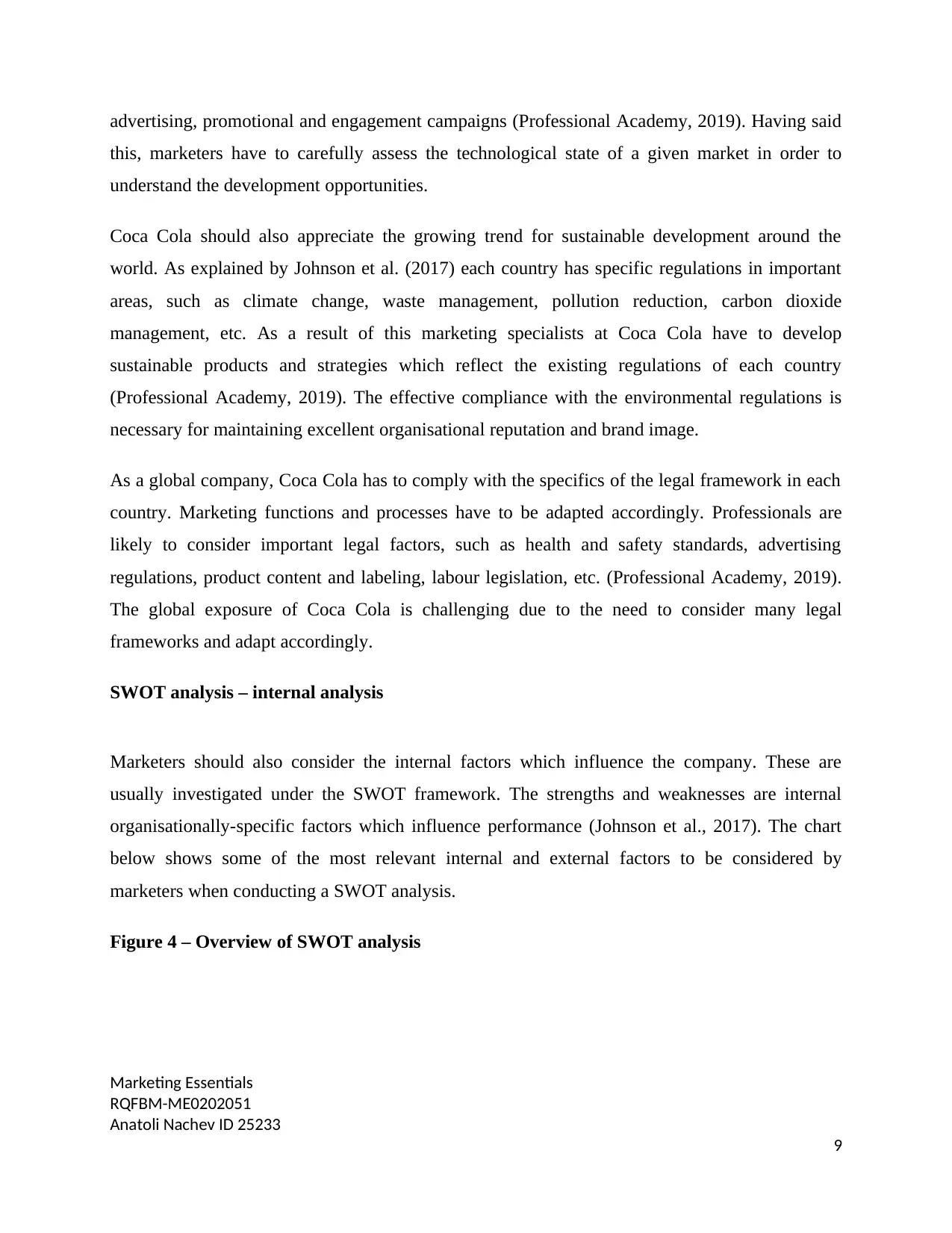
advertising, promotional and engagement campaigns (Professional Academy, 2019). Having said
this, marketers have to carefully assess the technological state of a given market in order to
understand the development opportunities.
Coca Cola should also appreciate the growing trend for sustainable development around the
world. As explained by Johnson et al. (2017) each country has specific regulations in important
areas, such as climate change, waste management, pollution reduction, carbon dioxide
management, etc. As a result of this marketing specialists at Coca Cola have to develop
sustainable products and strategies which reflect the existing regulations of each country
(Professional Academy, 2019). The effective compliance with the environmental regulations is
necessary for maintaining excellent organisational reputation and brand image.
As a global company, Coca Cola has to comply with the specifics of the legal framework in each
country. Marketing functions and processes have to be adapted accordingly. Professionals are
likely to consider important legal factors, such as health and safety standards, advertising
regulations, product content and labeling, labour legislation, etc. (Professional Academy, 2019).
The global exposure of Coca Cola is challenging due to the need to consider many legal
frameworks and adapt accordingly.
SWOT analysis – internal analysis
Marketers should also consider the internal factors which influence the company. These are
usually investigated under the SWOT framework. The strengths and weaknesses are internal
organisationally-specific factors which influence performance (Johnson et al., 2017). The chart
below shows some of the most relevant internal and external factors to be considered by
marketers when conducting a SWOT analysis.
Figure 4 – Overview of SWOT analysis
Marketing Essentials
RQFBM-ME0202051
Anatoli Nachev ID 25233
9
this, marketers have to carefully assess the technological state of a given market in order to
understand the development opportunities.
Coca Cola should also appreciate the growing trend for sustainable development around the
world. As explained by Johnson et al. (2017) each country has specific regulations in important
areas, such as climate change, waste management, pollution reduction, carbon dioxide
management, etc. As a result of this marketing specialists at Coca Cola have to develop
sustainable products and strategies which reflect the existing regulations of each country
(Professional Academy, 2019). The effective compliance with the environmental regulations is
necessary for maintaining excellent organisational reputation and brand image.
As a global company, Coca Cola has to comply with the specifics of the legal framework in each
country. Marketing functions and processes have to be adapted accordingly. Professionals are
likely to consider important legal factors, such as health and safety standards, advertising
regulations, product content and labeling, labour legislation, etc. (Professional Academy, 2019).
The global exposure of Coca Cola is challenging due to the need to consider many legal
frameworks and adapt accordingly.
SWOT analysis – internal analysis
Marketers should also consider the internal factors which influence the company. These are
usually investigated under the SWOT framework. The strengths and weaknesses are internal
organisationally-specific factors which influence performance (Johnson et al., 2017). The chart
below shows some of the most relevant internal and external factors to be considered by
marketers when conducting a SWOT analysis.
Figure 4 – Overview of SWOT analysis
Marketing Essentials
RQFBM-ME0202051
Anatoli Nachev ID 25233
9
⊘ This is a preview!⊘
Do you want full access?
Subscribe today to unlock all pages.

Trusted by 1+ million students worldwide
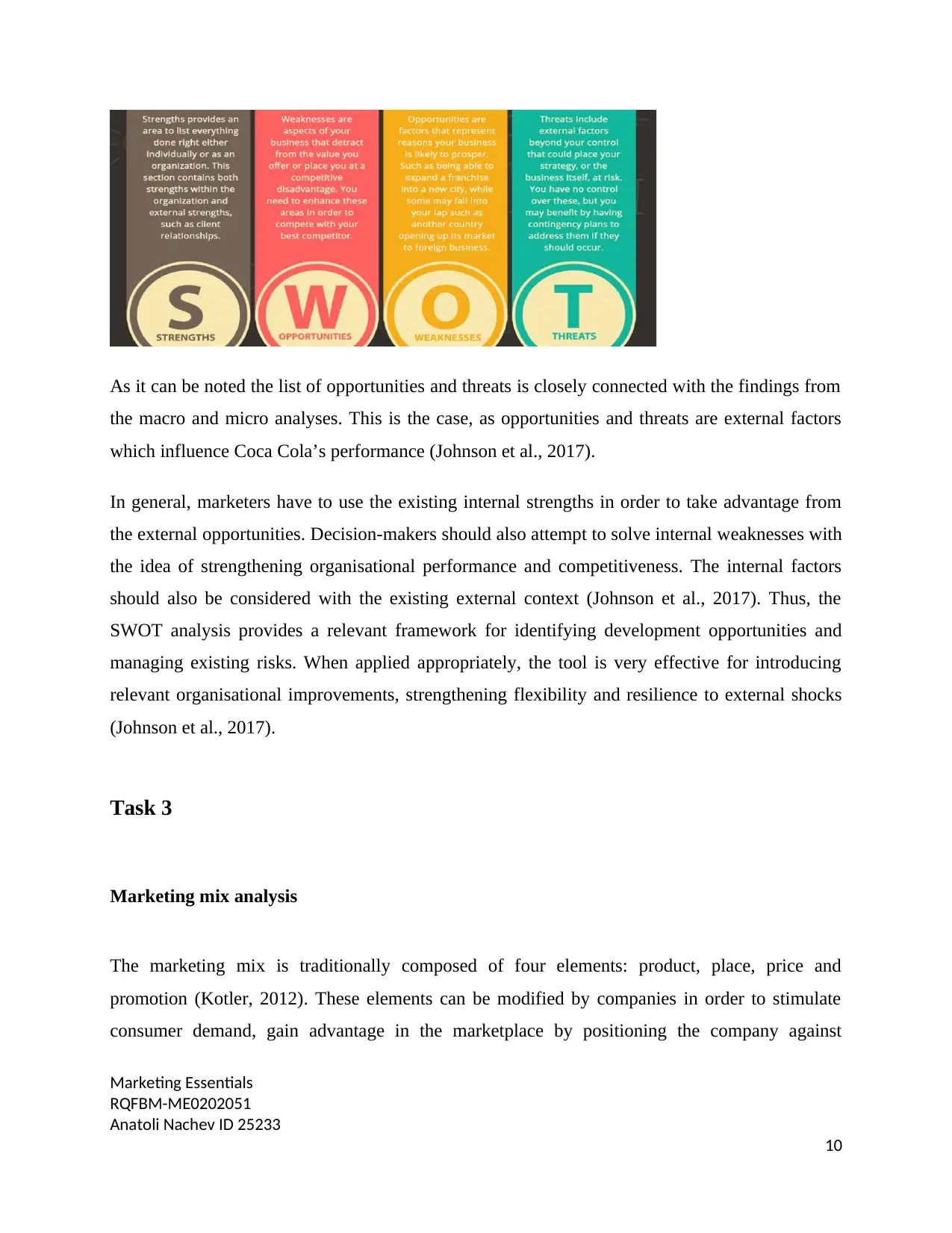
As it can be noted the list of opportunities and threats is closely connected with the findings from
the macro and micro analyses. This is the case, as opportunities and threats are external factors
which influence Coca Cola’s performance (Johnson et al., 2017).
In general, marketers have to use the existing internal strengths in order to take advantage from
the external opportunities. Decision-makers should also attempt to solve internal weaknesses with
the idea of strengthening organisational performance and competitiveness. The internal factors
should also be considered with the existing external context (Johnson et al., 2017). Thus, the
SWOT analysis provides a relevant framework for identifying development opportunities and
managing existing risks. When applied appropriately, the tool is very effective for introducing
relevant organisational improvements, strengthening flexibility and resilience to external shocks
(Johnson et al., 2017).
Task 3
Marketing mix analysis
The marketing mix is traditionally composed of four elements: product, place, price and
promotion (Kotler, 2012). These elements can be modified by companies in order to stimulate
consumer demand, gain advantage in the marketplace by positioning the company against
Marketing Essentials
RQFBM-ME0202051
Anatoli Nachev ID 25233
10
the macro and micro analyses. This is the case, as opportunities and threats are external factors
which influence Coca Cola’s performance (Johnson et al., 2017).
In general, marketers have to use the existing internal strengths in order to take advantage from
the external opportunities. Decision-makers should also attempt to solve internal weaknesses with
the idea of strengthening organisational performance and competitiveness. The internal factors
should also be considered with the existing external context (Johnson et al., 2017). Thus, the
SWOT analysis provides a relevant framework for identifying development opportunities and
managing existing risks. When applied appropriately, the tool is very effective for introducing
relevant organisational improvements, strengthening flexibility and resilience to external shocks
(Johnson et al., 2017).
Task 3
Marketing mix analysis
The marketing mix is traditionally composed of four elements: product, place, price and
promotion (Kotler, 2012). These elements can be modified by companies in order to stimulate
consumer demand, gain advantage in the marketplace by positioning the company against
Marketing Essentials
RQFBM-ME0202051
Anatoli Nachev ID 25233
10
Paraphrase This Document
Need a fresh take? Get an instant paraphrase of this document with our AI Paraphraser
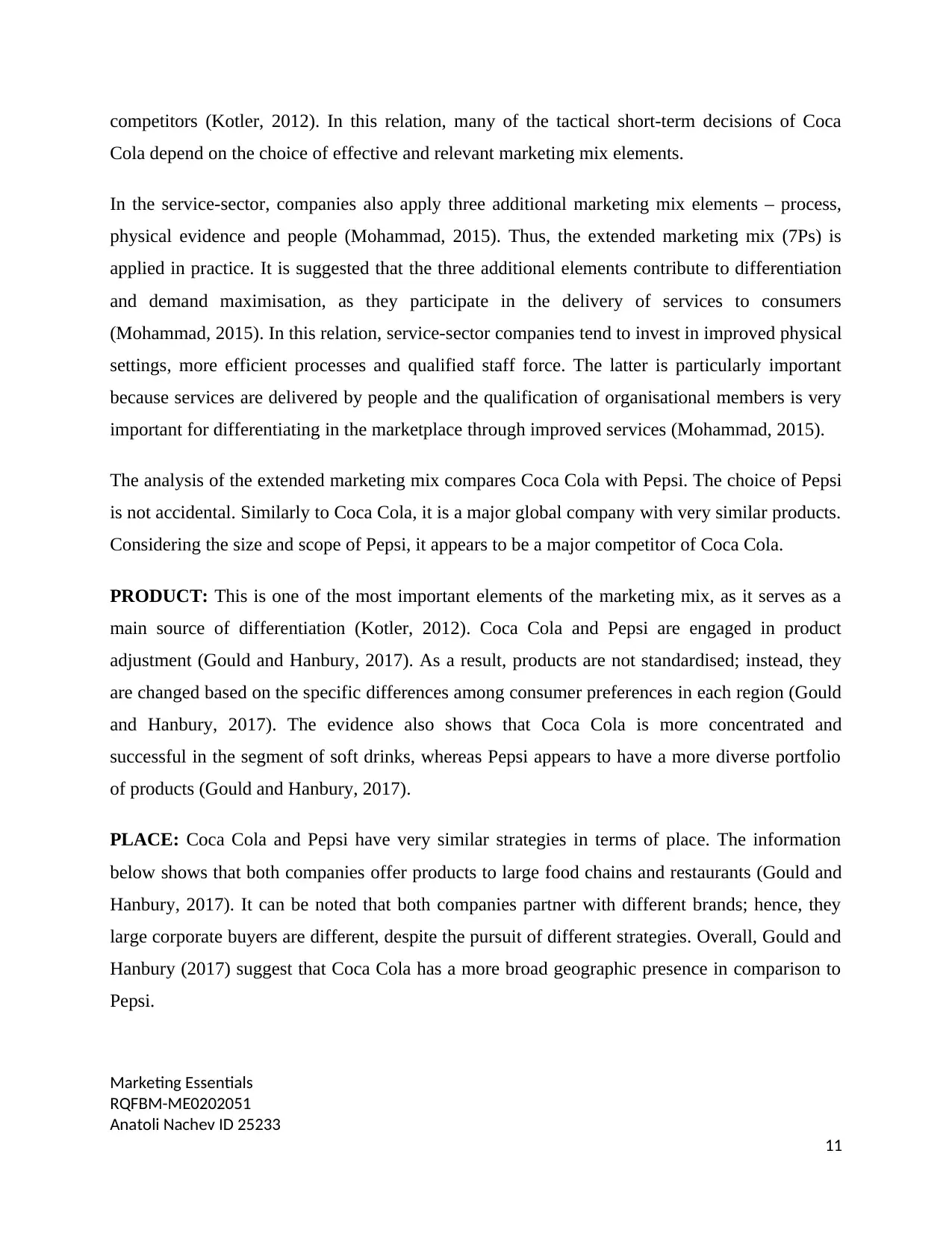
competitors (Kotler, 2012). In this relation, many of the tactical short-term decisions of Coca
Cola depend on the choice of effective and relevant marketing mix elements.
In the service-sector, companies also apply three additional marketing mix elements – process,
physical evidence and people (Mohammad, 2015). Thus, the extended marketing mix (7Ps) is
applied in practice. It is suggested that the three additional elements contribute to differentiation
and demand maximisation, as they participate in the delivery of services to consumers
(Mohammad, 2015). In this relation, service-sector companies tend to invest in improved physical
settings, more efficient processes and qualified staff force. The latter is particularly important
because services are delivered by people and the qualification of organisational members is very
important for differentiating in the marketplace through improved services (Mohammad, 2015).
The analysis of the extended marketing mix compares Coca Cola with Pepsi. The choice of Pepsi
is not accidental. Similarly to Coca Cola, it is a major global company with very similar products.
Considering the size and scope of Pepsi, it appears to be a major competitor of Coca Cola.
PRODUCT: This is one of the most important elements of the marketing mix, as it serves as a
main source of differentiation (Kotler, 2012). Coca Cola and Pepsi are engaged in product
adjustment (Gould and Hanbury, 2017). As a result, products are not standardised; instead, they
are changed based on the specific differences among consumer preferences in each region (Gould
and Hanbury, 2017). The evidence also shows that Coca Cola is more concentrated and
successful in the segment of soft drinks, whereas Pepsi appears to have a more diverse portfolio
of products (Gould and Hanbury, 2017).
PLACE: Coca Cola and Pepsi have very similar strategies in terms of place. The information
below shows that both companies offer products to large food chains and restaurants (Gould and
Hanbury, 2017). It can be noted that both companies partner with different brands; hence, they
large corporate buyers are different, despite the pursuit of different strategies. Overall, Gould and
Hanbury (2017) suggest that Coca Cola has a more broad geographic presence in comparison to
Pepsi.
Marketing Essentials
RQFBM-ME0202051
Anatoli Nachev ID 25233
11
Cola depend on the choice of effective and relevant marketing mix elements.
In the service-sector, companies also apply three additional marketing mix elements – process,
physical evidence and people (Mohammad, 2015). Thus, the extended marketing mix (7Ps) is
applied in practice. It is suggested that the three additional elements contribute to differentiation
and demand maximisation, as they participate in the delivery of services to consumers
(Mohammad, 2015). In this relation, service-sector companies tend to invest in improved physical
settings, more efficient processes and qualified staff force. The latter is particularly important
because services are delivered by people and the qualification of organisational members is very
important for differentiating in the marketplace through improved services (Mohammad, 2015).
The analysis of the extended marketing mix compares Coca Cola with Pepsi. The choice of Pepsi
is not accidental. Similarly to Coca Cola, it is a major global company with very similar products.
Considering the size and scope of Pepsi, it appears to be a major competitor of Coca Cola.
PRODUCT: This is one of the most important elements of the marketing mix, as it serves as a
main source of differentiation (Kotler, 2012). Coca Cola and Pepsi are engaged in product
adjustment (Gould and Hanbury, 2017). As a result, products are not standardised; instead, they
are changed based on the specific differences among consumer preferences in each region (Gould
and Hanbury, 2017). The evidence also shows that Coca Cola is more concentrated and
successful in the segment of soft drinks, whereas Pepsi appears to have a more diverse portfolio
of products (Gould and Hanbury, 2017).
PLACE: Coca Cola and Pepsi have very similar strategies in terms of place. The information
below shows that both companies offer products to large food chains and restaurants (Gould and
Hanbury, 2017). It can be noted that both companies partner with different brands; hence, they
large corporate buyers are different, despite the pursuit of different strategies. Overall, Gould and
Hanbury (2017) suggest that Coca Cola has a more broad geographic presence in comparison to
Pepsi.
Marketing Essentials
RQFBM-ME0202051
Anatoli Nachev ID 25233
11
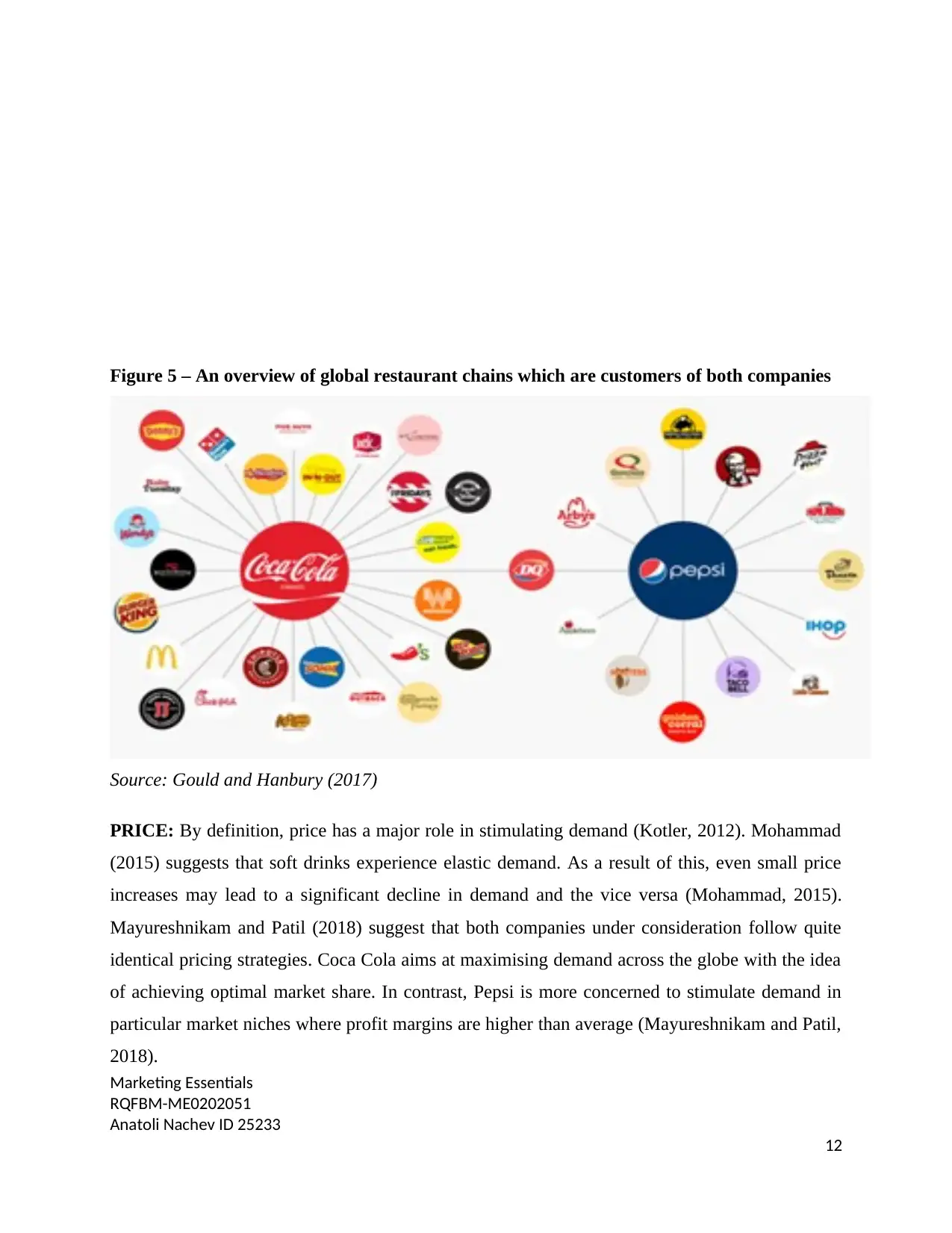
Figure 5 – An overview of global restaurant chains which are customers of both companies
Source: Gould and Hanbury (2017)
PRICE: By definition, price has a major role in stimulating demand (Kotler, 2012). Mohammad
(2015) suggests that soft drinks experience elastic demand. As a result of this, even small price
increases may lead to a significant decline in demand and the vice versa (Mohammad, 2015).
Mayureshnikam and Patil (2018) suggest that both companies under consideration follow quite
identical pricing strategies. Coca Cola aims at maximising demand across the globe with the idea
of achieving optimal market share. In contrast, Pepsi is more concerned to stimulate demand in
particular market niches where profit margins are higher than average (Mayureshnikam and Patil,
2018).
Marketing Essentials
RQFBM-ME0202051
Anatoli Nachev ID 25233
12
Source: Gould and Hanbury (2017)
PRICE: By definition, price has a major role in stimulating demand (Kotler, 2012). Mohammad
(2015) suggests that soft drinks experience elastic demand. As a result of this, even small price
increases may lead to a significant decline in demand and the vice versa (Mohammad, 2015).
Mayureshnikam and Patil (2018) suggest that both companies under consideration follow quite
identical pricing strategies. Coca Cola aims at maximising demand across the globe with the idea
of achieving optimal market share. In contrast, Pepsi is more concerned to stimulate demand in
particular market niches where profit margins are higher than average (Mayureshnikam and Patil,
2018).
Marketing Essentials
RQFBM-ME0202051
Anatoli Nachev ID 25233
12
⊘ This is a preview!⊘
Do you want full access?
Subscribe today to unlock all pages.

Trusted by 1+ million students worldwide
1 out of 27
Related Documents
Your All-in-One AI-Powered Toolkit for Academic Success.
+13062052269
info@desklib.com
Available 24*7 on WhatsApp / Email
![[object Object]](/_next/static/media/star-bottom.7253800d.svg)
Unlock your academic potential
Copyright © 2020–2025 A2Z Services. All Rights Reserved. Developed and managed by ZUCOL.

